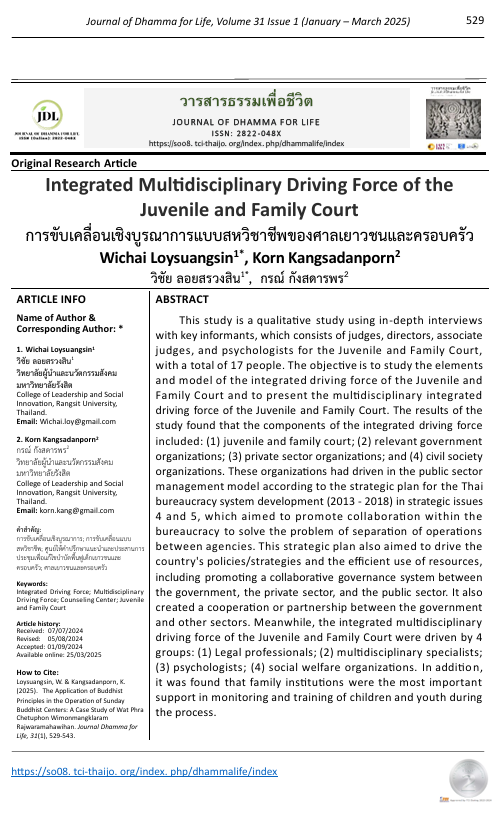การขับเคลื่อนเชิงบูรณาการแบบสหวิชาชีพของศาลเยาวชนและครอบครัว
Main Article Content
บทคัดย่อ
การศึกษานี้เป็นการศึกษาเชิงคุณภาพด้วยการสัมภาษณ์เชิงลึกผู้ให้ข้อมูลหลัก ซึ่งประกอบด้วยผู้พิพากษา ผู้อำนวยการ ผู้พิพากษาสมทบและนักจิตวิทยาประจำศาลเยาวชนและครอบครัว รวมทั้งสิ้น 17 ท่าน โดยมีวัตถุประสงค์ 1) เพื่อศึกษา องค์ประกอบและรูปแบบการขับเคลื่อนเชิงบูรณาการของศาลเยาวชนและครอบครัวและ 2) เพื่อนำเสนอการขับเคลื่อนเชิงบูรณาการแบบสหวิชาชีพของศาลเยาวชนและครอบครัว ผลการศึกษาพบว่า องค์ประกอบของการขับเคลื่อนเชิงบูรณาการ จะประกอบด้วย 1) ศาลเยาวชนและครอบครัว 2) องค์กรภาครัฐที่เกี่ยวข้อง 3) องค์กรภาคเอกชน 4) องค์กรภาคประชาสังคม ที่ขับเคลื่อนในรูปแบบการบริหารจัดการภาครัฐตามแผนยุทธศาสตร์การพัฒนาระบบราชการไทย (พ.ศ.2556 - พ.ศ.2561) ในประเด็นยุทธศาสตร์ที่ 4 และ 5 ซึ่งมีเป้าหมายเพื่อส่งเสริมการทำงานร่วมกันภายในระบบราชการด้วยกันเองเพื่อแก้ปัญหาการแยกส่วนในการปฏิบัติงานระหว่างหน่วยงาน และเพื่อขับเคลื่อนนโยบาย/ยุทธศาสตร์ของประเทศและการใช้ประโยชน์ทรัพยากรอย่างคุ้มค่า รวมทั้งการส่งเสริมระบบการบริหารกิจการบ้านเมืองแบบร่วมมือกันระหว่างภาครัฐ ภาคเอกชน และภาคประชาชน รวมทั้งการสร้างความร่วมมือหรือความเป็นภาคีหุ้นส่วน (Partnership) ระหว่างภาครัฐและภาคส่วนอื่น ในขณะที่การขับเคลื่อนเชิงบูรณาการแบบสหวิชาชีพของศาลเยาวชนและครอบครัวจะเป็นการขับเคลื่อนโดยบุคคล 4 กลุ่ม ได้แก่ 1. กลุ่มนักวิชาชีพด้านกฎหมาย 2. กลุ่มนักสหวิชาชีพ 3. กลุ่มนักจิตวิทยา 4. กลุ่มองค์กรสังคมสงเคราะห์ นอกจากนี้พบว่าสถาบันครอบครัวเป็นกลุ่มสนับสนุนที่สำคัญที่สุดในการติดตามและอบรมดูแลเด็กและเยาวชนในระหว่างกระบวนการ


